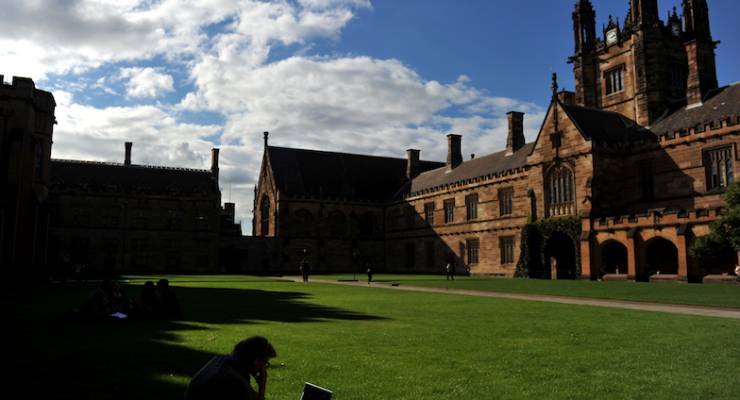
Australia’s $35 billion international student sector will take a further hit after authorities in China cancelled critical English language tests for a second month to stem the spread of the coronavirus.
The International English Language Testing System (IELTS) test is a cornerstone requirement for foreign students to enrol in almost all Australian university courses.
The sector is concerned that test rooms will also be shuttered in March and possibly into the middle of the year.
More than 800 people have died from the virus in China, from a total 37,000 people infected. Scientists say the infection numbers are under-reported, in part because of a lack of testing kits in the Hubei province epicentre and the lack of any testing competency in places throughout the Asia-Pacific region.
Although most Australian universities are allowed to set their own requirements with regard to English language for Chinese students, IELTS is the de facto international standard in Australia.
Right now universities are in the dark, with no idea how big a hit they will take as the result of the virus. Some are estimating a full-blown crisis could take 10% off revenues. There are an estimated 164,000 Chinese students in Australia.
Fresh problems will emerge if the ban is not lifted by April, squeezing time-frames of the second semester intake. Almost all universities have only two intakes (March and August). UNSW has a unique problem though, with its switch to a three-term year in 2019. Its second intake will be affected if the ban stays until only March.
The country’s top eight (Go8) universities have the highest demand from China, so they are able to lock in their enrolments months in advance. All unis are marketing and taking enrolments all the way into week one, but these last-minute students make up a larger proportion of the cohort for those outside the Go8.
An industry insider, who declined to be named, told Crikey “It’s a frantic last-minute revenue grab — Chinese students who don’t succeed in securing their first-preference course are fielding offers. Marketing teams are swarming in Australia and on the ground in China in the hope of convincing as many as possible”.
Another significant cohort that is more likely to be left stranded without an IELTS certificate are the students who change institution — they must complete a new IELTS course after returning home in November.
IELTS tests are also need for foundation courses — a preparatory year to bring student up to pace in English — that start a little earlier in mid-February and are feeder courses for universities. Lower numbers in foundation courses in 2019 will mean Chinese student numbers take a further hit in 2020.
The sector already has a financial headache. This year it was experiencing the first drop-off in Chinese student numbers since Australia’s international education boom kicked off at the turn of the century. Chinese student numbers dropped, prior to any news of the virus, due to a range of factors including fallout from the chilly political relations between the Australian government and China that plays out in Chinese state-run media and dark warnings from the countries’ education authorities.
People familiar with enrolments across foundations courses say they are seeing further declines this year. These courses are taken mainly in Australia.
The additional impact of the virus is already being felt keenly by the sector.
The University of Sydney has told agents that it will extend enrolments to March 31, and Monash has extended for two weeks to March 9. This effectively extends the so-called census date, before which students can cancel enrolments to with no financial penalty. Others are preparing for similar emergency measures.
Health and science courses, for example, tend to run full-year courses, meaning that they will potentially be hit harder.
But whether this situation moves from being problematic to a full-blown crisis will rest on when the government’s ban on travel from China to Australia ends.
Internal risk assessment obtained by Crikey from a company working in the sector said there is only a low risk to universities if infections start to reduce shortly. If the ban lifted is by Feb 28, the damage would be containable — but this has a low probability.
If the travel ban stretched into June, the analysis said the risk level to universities would rise to medium; it would impose considerable financial strain in certain courses and institutions, especially the Go8 which is most reliant on the Chinese market .
If the travel ban continued until September, this would be a genuine crisis.








Given the amount of bile our writers constantly spew out about “the Chinese”, they’d probably be wise to stay at home.
“Another significant cohort that is more likely to be left stranded without an IELTS certificate are the students who change institution — they must complete a new IELTS course after returning home in November.”
As a TESOL with many years of English language teaching experience in Asia, though not in China, I find this statement puzzling. It is generally recommended that an IELTS score is good for two years after the test is taken. However if a student has been studying in an English speaking country during that two years they should be able to demonstrate that they have maintained their expertise level and not be required to re-test.
For example an undergraduate student I taught in first year of university, completed the IELTS three years ago before taking up an MEd program at an Aus university. She completed her two year course, returned home for one year and then won a PhD scholarship to return to Australia. She did not have to re-take IELTS.
Your corresondent talks about ‘chilly rea;tions’ prior to the virus utbreak, leading to reduced enrolments. He attributes the reduced number to the effect of Chinese Sate run media. It is equally likely that the continuous drip feed of anti Chinese paranoia from Australian media, led as much by the Age as the Murdoch network, that would put off many students from coming here.
Your corresondent talks about ‘chilly rea;tions’ prior to the virus utbreak, leading to reduced enrolments. He attributes the reduced number to the effect of Chinese Sate run media. It is equally likely that the continuous drip feed of anti Chinese paranoia from Australian media, led as much by the Age as the Murdoch network, that would put off many students from coming here.
It is instructive to examine how these universities came to be in this situation where they seem to be deeply dependent on ‘foreign’…mainly Chinese…students.
Surely the Federal government has a lot to answer for in not adequately funding our university sector in the first place…but said universities should NEVER have compromised their services by ‘filling the gap’ with foreign students to this extent.
It is hard to feel sorry for either government(s) or universities, since both appear to have brought this crisis on themselves!